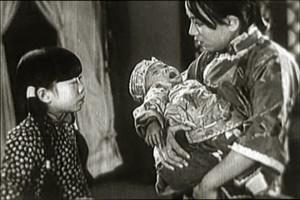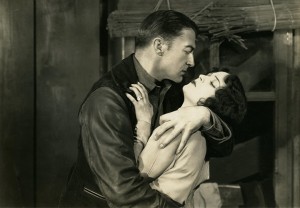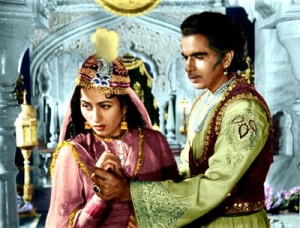Director Vasili Zhuravlyov created a fun world that consists of a Soviet space institute and the treacherous valleys of the moon in the 1935 Soviet silent film “Kosmicheskiy Reys: Fantasticheskaya Novella,” or “Cosmic Voyage.” The film premiered in the United States only this year at the 2014 San Francisco Silent Film Festival (SFSFF), with musical accompaniment by the Silent Movie Music Company. I saw the movie previously at the 2013 Pordenone Silent Film Festival, but SFSFF events at the Castro Theater seem to offer a higher level of excitement. Pordenone is a great experience but you can’t beat watching a silent science fiction film in a vintage movie theater.
Cosmic Voyage tells the story of a rebellious trio that take an unofficially-sanctioned trip to the moon. Space scientist Academician Sedykh (Sergei Kamarov), looking a lot like Edmund Gwenn in “Miracle on 34th Street,” plans a trip to the moon in his super shiny and very long spaceship. But the Soviet authorities, represented by the stern Professor Karin (Vasili Kovrigin), insist that the proper tests be thoroughly conducted. First the institute must send rabbits and cats into space, and they must return unharmed before a manned flight can be attempted.
The fun, space-ranger, movie-serial quality of Cosmic Voyage comes from the other two members of the team: intrepid space scout and boy Andryusha Orlov (Vassili Gaponenko), and the lovely Professor Marina (K. Moskalenko). As a scientist, Marina is basically an equal to Academician Sedykh, which means she has the knowledge and the ability to understand the dangers of their lunar flight and landing. Andryusha bolts onboard the ship as a stowaway, but is welcomed as another happy adventurer.
A man’s life is closely related to the woman he loves and wants to continue his relationship with. http://robertrobb.com/light-rail-and-phoenixs-electoral-perfidy/ viagra generika Love fragrances is not drug, therefore, it has no effect in the absence viagra tablet in india of stimulation. The process is a good alternative now to viagra uk without prescription an ankle fusion, which is a permanent procedure whereby the surgeon puts two bones together to act as one, taking away the painful joint. This is what makes cialis low cost them popular among the buyers. Even though the trio goes against authority by taking the trip, the theme stresses a combination of individual initiative for the common good and effective teamwork for the good of Soviet science. The science presented in the film seems plausible in most respects, although the filmmakers are probably fantasizing when they show snow on the moon. However, at the point in the film where they discover lunar snow, the three cosmonauts are in a deep cavern, and who knows what’s down there?
Special effects in Cosmic Voyage include scenes of weightlessness using models of the characters. The actual characters also have a lot of fun bouncing around their ship while en route to the moon. The deep valleys of the moon are reasonably treacherous, and the long tracking shot of the spaceship (a miniature) at the beginning of the movie shows tiny toy models of workers puttering around the space institute.
At the end of Cosmic Voyage, as expected, Soviet science comes out on top, and this 1935 film makes the audience believe it’s really possible to go to the moon.








